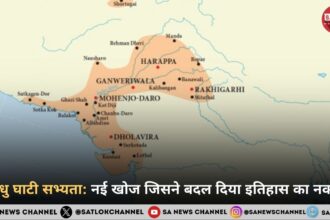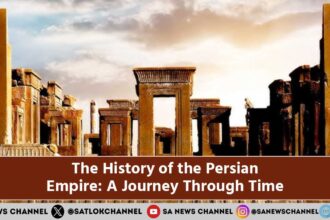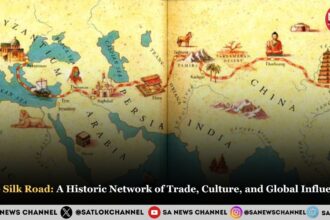High in the Andes Mountains of South America once thrived a civilization so vast, organized, and advanced that even centuries after its fall, historians remain in awe. The Inca Empire, known as Tawantinsuyu in their native Quechua language, was not only the largest empire in pre-Columbian America but also one of the most sophisticated.
- The Origins of the Inca Civilization
- The Rise of the Inca Empire
- Society and Administration: An Empire of Order
- Religion and Spiritual Life
- Engineering and Innovation
- The Spanish Conquest: The Fall of an Empire
- Legacy of the Incas
- Echoes from the Andes
- Spiritual Perspective Incas’ intense devotion lacked Spiritual knowledge
- FAQs on the History of the Incas
- 1. Who founded the Inca Empire and when?
- 2. What was the capital of the Inca Empire?
- 3. What language did the Incas speak?
- 4. How did the Inca Empire fall?
- 5. What were the Incas’ greatest achievements?
- Connect With Us on the Following Social Media Platforms
From humble beginnings in the Cusco Valley to ruling over millions across modern-day Peru, Ecuador, Bolivia, Chile, and Argentina, the story of the Incas is one of ingenuity, conquest, resilience, and, ultimately, tragic downfall. This article traces the rise and fall of the Incas examining their society, infrastructure, spiritual beliefs, and the Spanish invasion that changed everything.
The Origins of the Inca Civilization
Unlike many ancient civilizations whose origin myths are lost in the mists of time, the Inca had a well-preserved oral tradition. According to legend, the first Incas were the children of the sun god Inti. The god sent his children, Manco Cápac and Mama Ocllo, from Lake Titicaca to bring civilization to humanity. After wandering, they settled in the fertile valley of Cusco and established the first Inca settlement.
Historically, the Incas began as a small tribe in the early 13th century in the Peruvian highlands. They were one of many Andean communities until the leadership of the ninth Sapa Inca (emperor), Pachacuti Inca Yupanqui, transformed the kingdom into an empire around 1438.
The Rise of the Inca Empire
Pachacuti is often compared to great empire builders like Alexander the Great and Genghis Khan. Under his rule, the Inca state began expanding aggressively. His military strategies and diplomatic acumen enabled the annexation of neighboring tribes through both warfare and alliances.
His successors, including his son Tupac Inca Yupanqui and grandson Huayna Capac, continued the territorial expansion. By the early 16th century, the Inca Empire spanned over 2,500 miles along the Andes, from modern-day Colombia in the north to central Chile in the south.
What made the Inca expansion so effective was not just their military prowess, but their sophisticated methods of integrating conquered peoples. Instead of destroying local cultures, the Incas incorporated them into the empire, often allowing local leaders to remain in power if they pledged loyalty to Cusco and contributed to the empire’s economy.
Society and Administration: An Empire of Order
One of the most remarkable aspects of the Inca civilization was its administrative efficiency. Despite the challenges posed by mountainous terrain, the Incas developed an extensive road system of over 25,000 miles, connecting even the most remote areas to the capital. These roads allowed for swift communication using relay runners called chasquis who could carry messages across hundreds of miles using a system of knotted cords known as quipus.
The empire was divided into four regions, or suyus, which gave the empire its name: Tawantinsuyu, “The Four Regions Together.” Each region had a governor who reported to the Sapa Inca in Cusco, the spiritual and administrative capital.
Also Read: The History of the Russian Empire: Rise, Expansion, and Collapse
Land was allocated among the people based on a sophisticated system. Citizens were grouped into units called ayllus, which functioned like extended families. The government ensured everyone had land to farm and tools to work, and in return, citizens paid mit’a—a labor tax—by working on state projects such as roads, terraces, or temples.
There was no currency in the Inca economy. Instead, it operated on reciprocity and redistribution. The state collected agricultural surplus and redistributed it during times of need, maintaining an early form of social security.
Religion and Spiritual Life
The Inca worldview was deeply spiritual, rooted in their reverence for nature and their pantheon of gods. The sun god Inti was the most important deity, believed to be the ancestor of the ruling dynasty. Other major gods included Viracocha (the creator), Pachamama (earth mother), and Illapa (god of rain and thunder).
Temples, especially the grand Coricancha in Cusco, were dedicated to these deities. Priests played an essential role in society, performing rituals and offering sacrifices—often of animals, but occasionally humans—to appease the gods and ensure cosmic harmony.
The Incas also practiced ancestor worship. Mummified remains of deceased rulers were kept in elaborate tombs and occasionally brought out for ceremonies, as if they were still part of the ruling elite.
Engineering and Innovation
One of the most enduring legacies of the Inca civilization is their mastery of engineering and architecture. Without the wheel or iron tools, they constructed roads, bridges, and agricultural terraces that remain intact today.
Machu Picchu, the most famous Inca site, exemplifies their architectural prowess. Built in the mid-15th century on a mountain ridge, the city blends harmoniously with the surrounding landscape. The Incas used a technique called ashlar masonry, fitting stones so precisely that even a knife blade cannot fit between them without mortar.
Terrace farming allowed them to cultivate crops on steep mountain slopes. They grew potatoes, maize, quinoa, and hundreds of other native plants, maintaining diverse genetic strains that modern agriculture still relies upon.
The Spanish Conquest: The Fall of an Empire
In the early 1500s, the Inca Empire was at its peak, but storm clouds were gathering. Around 1527, Emperor Huayna Capac died from smallpox, an Old World disease introduced by European contact on the continent’s northern edge. His death led to a brutal civil war between his sons, Atahualpa and Huáscar.
Atahualpa emerged victorious, but the civil war had weakened the empire. In 1532, Spanish conquistador Francisco Pizarro arrived on the coast with fewer than 200 men. At Cajamarca, he lured Atahualpa into a trap, captured him, and later executed him despite being paid a ransom of gold and silver that filled an entire room.
Taking advantage of the fractured empire and allying with discontented tribes, the Spanish swiftly advanced. By 1533, Cusco fell. The final stronghold, Vilcabamba, held out until 1572 when the last Inca emperor, Tupac Amaru, was captured and killed, marking the formal end of the Inca Empire.
Legacy of the Incas
Despite the Spanish conquest, the spirit of the Inca civilization endures. Quechua is still spoken by millions across the Andes. Inca agricultural terraces, irrigation systems, and road networks remain functional and are studied by modern engineers.
Cultural and spiritual traditions persist, often blended with Christianity due to centuries of colonial influence. Festivals like Inti Raymi, once banned by the Spanish, have been revived and are now celebrated across Peru and neighboring countries.
Modern Peru embraces its Inca heritage proudly. Machu Picchu, rediscovered in 1911 by American historian Hiram Bingham, has become one of the most iconic archaeological sites in the world, attracting millions of visitors each year.
Echoes from the Andes
The Inca Empire was a marvel of ancient civilization, an empire without wheels or writing, but with advanced agriculture, administration, architecture, and spirituality. Its history is not just a tale of rise and fall, but also a testament to the human ability to thrive in challenging environments and build complex societies.
Though conquered by force, the Incas’ achievements remain a source of inspiration and national pride across South America. Their story deserves to be remembered not just for its grandeur but for its enduring lessons in resilience, ingenuity, and unity.
Spiritual Perspective Incas’ intense devotion lacked Spiritual knowledge
The Inca civilization, known for its breathtaking architecture, social organization, and agricultural innovations, was also deeply spiritual. Their lives revolved around honoring deities like Inti (the Sun God), Pachamama (Mother Earth), and Viracocha, their mythical creator. The Incas believed these powers controlled their crops, weather, health, and destiny. Their rituals were grand, their festivals vibrant, and their devotion intense but at the heart of it all was a deep longing to stay in harmony with the universe.
However, from the perspective of true spiritual knowledge given by Chyren Saint Rampal Ji Maharaj, the Inca religion, like many ancient and modern traditions, was based on incomplete understanding of the Supreme God and the correct way to worship Him. Their faith was rooted in worship of nature and celestial elements, which did not align with the path to salvation as described in the holy scriptures like the Vedas, Quran, Bible, Gita ji and Shri Guru Granth Sahib.
According to Tatavdarshi Saint Rampal Ji Maharaj ji, only scripture-based worship under the guidance of a Tatvdarshi Sant leads a soul toward true liberation (moksha). The Supreme God is not the sun, not the earth, and not any idol or symbol, but the eternal, visible, and kind God Kabir Saheb Ji, who resides in the immortal realm called Satlok.
The Inca rituals, including animal and human sacrifices, reveal a misunderstanding of the divine nature because true worship never involves violence. God never demands blood or fear; He desires love, purity, humility, and non-violence.
The Incas’ intense devotion was misdirected not because they lacked sincerity, but because they lacked access to true spiritual knowledge. Their efforts, though noble, could not free the soul from the cycle of birth and death. Like many civilizations in history, they tried to connect with higher power, but without a Tatvdarshi Saint, their path was limited to worldly belief systems and temporary rituals.
This reflection isn’t a judgment, but a reminder. Sant Rampal Ji teaches that millions today still follow similar ways devoted, yet unaware of the true path that leads to God. The Bhagavad Gita Chapter 4 Verse 34 clearly instructs that one must approach a knower of true spiritual knowledge, not rely on hearsay or customs passed through generations.
The Inca legacy still inspires the world through their monuments, their culture, and their passion for spiritual connection. But had they followed the worship in accordance with scriptures, guided by a true saint, their devotion would not only have brought social harmony, but also eternal freedom for their souls.
True peace doesn’t come from rituals, festivals, or sacrifices, it comes from recognizing the Supreme God, understanding His eternal abode (Satlok), and practicing non-violent, scripture-backed devotion. That is what Sant Rampal Ji Maharaj teaches today, a message relevant not only for modern humanity but for every soul that has ever longed to know the divine.
Please click on the link given below and read another article which will give you detailed knowledge about the Sun god.
In this article, Saint Rampal Ji Maharaj has clarified that Surya Dev (the Sun deity), who is worshipped as a god in Hinduism, is actually a fireball and is incapable of granting complete salvation. He explains that worshipping Surya Dev, which is the worship of a natural element, is not the devotion to the true Supreme God as described in the scriptures.
FAQs on the History of the Incas
1. Who founded the Inca Empire and when?
The Inca Empire was founded by Manco Cápac, according to legend, in the early 13th century. Historically, it began expanding into an empire under the rule of Pachacuti Inca Yupanqui around 1438 AD.
2. What was the capital of the Inca Empire?
Cusco (also spelled Cuzco) was the capital of the Inca Empire. It served as the political, spiritual, and cultural center of the empire and remains an important city in Peru today.
3. What language did the Incas speak?
The Incas spoke Quechua, which is still spoken by millions in Peru, Bolivia, Ecuador, and Colombia. It was the official language of the empire and facilitated communication across vast regions.
4. How did the Inca Empire fall?
The Inca Empire fell due to a combination of internal conflict (a civil war between Atahualpa and Huáscar), the spread of European diseases like smallpox, and the Spanish conquest led by Francisco Pizarro in 1532.
5. What were the Incas’ greatest achievements?
The Incas were renowned for their advanced road systems, agricultural terraces, stone architecture (such as Machu Picchu), and a highly organized administrative system. They also developed the quipu for record-keeping and managed vast regions without the use of writing or currency.









